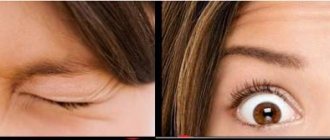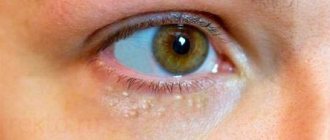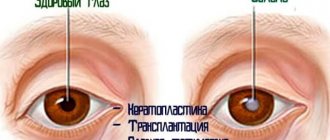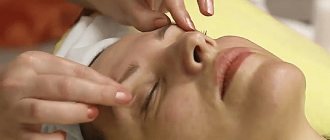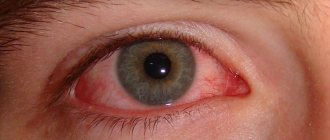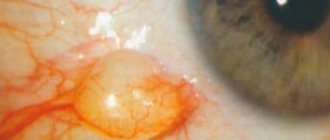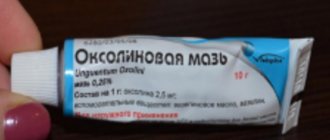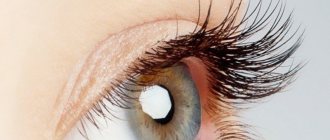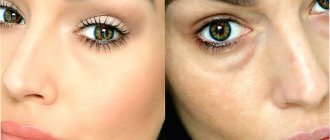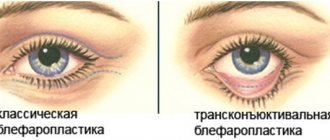An eyelid hernia is a very common problem these days, and it occurs in people of both mature and very young ages. Many people mistakenly believe that severe hernias can be removed using various cosmetics, but, alas, this is not the case. Hernias of the upper or lower eyelids are so-called “fat bags” hidden under the skin, so they can only be completely eliminated through surgery.
Of course, each case is individual, so you should not engage in self-diagnosis. Only a plastic surgeon can make the right decision on your problem, so the first step to removing an eyelid hernia will be a consultation with a doctor. There he will tell you about the characteristics of your skin, the causes of hernias on the upper or lower eyelids, and also suggest the most appropriate correction method.
What causes fatty hernias of the eyelids?
The main reasons for the appearance of such a deficiency are usually attributed to age-related changes in the skin. However, if eyelid hernias are present at a young age, most likely the cause is genetic predisposition or facial structure.
In addition, constant stress and lack of sleep, which are so important for residents of large cities, as well as the impact of ultraviolet rays on the area around the eyes have a negative impact.
Competent cosmetic care, health care and a healthy lifestyle will help significantly delay the appearance of fatty hernias, especially if the structure of your facial skin is not prone to severe ptosis.
Cost of the operation
The price range for lower blepharoplasty in specialized institutions in Moscow and St. Petersburg does not differ radically. It should be borne in mind that most clinics in their price lists indicate the cost of the operation itself, without taking into account the cost of consumables, consultations with specialists and hospital stay.
Average prices for lower eyelid blepharoplasty in Moscow and St. Petersburg:
| Moscow | Saint Petersburg | |
| Classical blepharoplasty of the lower eyelids, category 1 of complexity | From 40 thousand rubles | From 30 thousand rubles |
| Blepharoplasty, category 2 complexity | From 60 thousand rubles | 50 thousand rubles |
| Price range | 40 – 120 thousand rubles | 30–90 thousand rubles |
How can you remove eyelid hernias?
As mentioned above, the most effective method would be surgery – blepharoplasty. Don’t be afraid of it, the procedure is performed under local anesthesia, so you will be conscious and will be able to observe the surgeon’s actions
There are two options for blepharoplasty – classic and transconjunctival. The choice of method depends on the location of the eyelid hernia, as well as on the age and individual characteristics of the patient’s skin.
Only the classic version of blepharoplasty is performed on the upper eyelids. The doctor makes an incision using a scalpel and through it removes the fatty hernia from the upper eyelid. The incision runs exactly along the crease of the eyelid, so the scar will be practically invisible in the future. The operation lasts, on average, no more than an hour.
A lower eyelid hernia can be removed using either the classical method - in this case, the incision will be made exactly under the eyelash line - or the transconjunctival method. The latter is used when the patient does not have excess skin on the lower eyelids. Most often this happens in young people. The advantage of this method is that absolutely no traces are left after it, since the necessary incision is made from the mucous membrane of the eye. In addition, the recovery period after transconjunctival blepharoplasty is significantly shorter.
Ways to eliminate imperfections of the lower eyelid without surgery
Our clinic performs a range of procedures to correct the area under the eyes. Let's look at which options best help with different problems.
Puffiness under the eyes (photo 1)
Swelling can be eliminated using procedures that improve lymphatic drainage . These include vacuum diamond peeling or gas-liquid peeling jet peel. Treatment consists of a course of procedures, from 4 to 10 or more, depending on the manifestation and cause of the problem, if we are talking specifically about swelling caused by stagnation in the lower eyelid area.
Some formations that look like swelling are actually lower eyelid hernias . They are formed as a result of the redistribution and sliding of adipose tissue and a decrease in skin tone.
How to determine - edema or fatty hernia? If the size of the “bags” under the eyes varies: in the morning/evening, after the weekend/on weekdays, then most likely it is swelling.
Mesotherapy can also be used for swelling. Various meso-cocktails can strengthen the skin and remove dark circles, but a course of treatment is needed, since the effect of mesotherapy is cumulative. The course includes 3-5 procedures.
Hernia of the lower eyelid (photo 2,3)
Small hernias, as in photo 2, can be corrected using contour plastic surgery, provided that the problem is not advanced. The area of the nasolacrimal groove is filled with hyaluronic acid filler. The bags are “leveled out”, unevenness and wrinkles are smoothed out almost immediately, and the effect lasts 10-12 months. There is no rehabilitation period!
Large hernias (photo 3) often cannot be repaired using non-surgical methods. If the formation under the eyes “hangs” strongly and is a complete semicircle, from the medial to the lateral edge, then only plastic surgery will help.
During surgery, fat packets are removed or redistributed to make them less noticeable. The operation is not a pleasant thing, but it gives 100% results for a long time.
After surgery, you can recover for weeks. Therefore, it is better to prevent such situations in time. To do this, we recommend undergoing preventive procedures to strengthen the skin of the eyelids after 30 years.
Nasolacrimal groove (photo 4.5)
The deep furrow under the eyes is smoothed out using a combination of contouring with fillers and mesotherapy.
If the problem is advanced, then it can only be dealt with through comprehensive correction. These are fillers + laser correction + mesotherapy. Additionally, IPL may be required - a technique of so-called photorejuvenation. You and I will have to “sweat”, but if we do not eliminate the problem at this stage, then it will only get worse.
Rehabilitation period
Immediately after surgery, the patient should rest in the hospital room with ice packs over the eyes. This will help reduce pain and minimize swelling in the future. After being examined by a doctor, if everything is in order, you can go home the same day.
Sutures are removed on days 3-6; moderate pain or discomfort in the eye area is usually present only in the first days.
For two weeks you should avoid visiting bathhouses, saunas, do not take hot baths, reduce eye strain and protect them from direct sunlight.
You can go to work in just a few days wearing smoked glasses. You will be able to apply makeup in 10-14 days. Full recovery and the moment when the full result can be assessed occurs in 1.5-2 months.
Blepharoplasty: contraindications and limitations
The outcome of any operation is influenced not only by the experience and skill of the surgeon, but also by the individual characteristics of the body. Some diseases significantly affect the strength of the vascular wall, the speed of recovery after surgery and the ability to adapt. Therefore, it is so important to study contraindications before undergoing surgery.
Contraindications are:
- Acute and chronic inflammatory diseases in the active phase.
- Dry keratitis.
- Glaucoma and other conditions accompanied by increased pressure inside the eye.
- Chronic diseases during the period of decompensation, when the body is not in a stable condition (diabetes mellitus, heart and vascular diseases, liver).
- Diseases of the thyroid gland (hyper- and hypothyroidism, Graves' disease).
- Oncological diseases.
- Pregnancy and breastfeeding (lactation period).
- Congenital and acquired blood clotting defects.
This is a list of main contraindications. The need and possibility of surgery is determined after consultation and examination and diagnostic tests.
Removing an eyelid hernia without surgery
The possibility of such a correction, of course, exists, however, it is worth noting that it does not give such a pronounced result as surgery and is most often only an intermediate step on the path to blepharoplasty.
The most effective options are mesotherapy - during which a cosmetologist makes microinjections into the area around the eyes, as well as laser correction, which exfoliates cells at a deep level and accelerates the regenerative processes of the skin.
These methods are good at the initial stage of the problem, as they allow you to remove fine wrinkles, refresh your skin tone and get rid of slight swelling under the eyes. However, at later stages they will not give the desired result, so you should still give preference to blepharoplasty, the effect of which will last for years and will allow you to completely forget about the problem.
The concept of lower eyelid blepharoplasty
As a rule, the name of the operation is formed from Latin words, so it will sound the same in all languages. Blepharoplasty is one of the most popular plastic surgeries that allows you to correct all the imperfections and defects of the eyelid (in this case, the lower one). It helps eliminate visible imperfections such as excess skin, hernial “bags” under the eyes, drooping eyelids, small and large wrinkles. The operation helps not only to cope with age-related changes. Any visual defects can be corrected. For example, nasolacrimal groove plastic surgery has become very popular.
Video
Example of eyelid hernia removal
Price for eyelid hernia removal
| Name | Price |
| Surgical correction of hernias and skin of the lower eyelids with its atrophy | 75,000 rub. |
| Surgical correction of hernias and skin of the lower eyelids with its atrophy | 75,000 rub. |
| Surgical correction of the lower eyelids transconjunctivally | 75,000 rub. |
| Primary appointment (examination, consultation) with a plastic surgeon | FOR FREE |
Contraindications for surgery:
As with any surgical intervention, there are contraindications to blepharoplasty. These include diseases of the blood coagulation system, diabetes mellitus, increased intraocular pressure, dry eye syndrome, and oncology. Age is not a contraindication to surgery. If there are contraindications to general anesthesia, eyelid surgery can be performed under local anesthesia. In all other cases, if you are planning to have blepharoplasty, we invite you to a consultation with plastic surgeons at the ABIA clinic, St. Petersburg.
conclusions
As you can see, a lower eyelid hernia is a fairly common pathology that can occur in people for various reasons: from hereditary predisposition to negative environmental influences. However, it can also be effectively combated with modern conservative and surgical methods. The main thing in such treatment is to accurately determine the cause of the pathology, select the most effective way to eliminate it, and follow the doctor’s recommendations throughout the entire period of treatment.
Also read about such formations on the eyelids as milia and papillomas.
Causes
There are several causes of a lower eyelid hernia. These are:
- structural features of the orbit;
- genetic predisposition;
- hormonal problems;
- disturbances of lymphatic drainage in the orbital area;
- constant visual strain, which can occur during work that requires high concentration (for example, when working at a computer, assembling small parts and other similar activities);
- negative effects of UV radiation on the skin;
- stress and chronic fatigue.
Also, the presented pathology can be formed due to the thinning of the membrane of the lower eyelid. This can occur against the background of various ophthalmological diseases.
Possible complications
A lower eyelid hernia is considered a harmless disease. It extremely rarely gives any complications, even if a person does not start treatment for a long time. To a large extent this is a cosmetic defect. Also, this can lead to the acquisition of other diseases, for example epicanthus (we will look at what epicanthus is later).
Manifestation of lower eyelid hernia
The presented pathology can only harm those patients who have concomitant ophthalmological diseases, including frequent conjunctivitis, keratitis and other problems. This category of patients should seek medical help for a hernia as early as possible.
Prevention
It is almost impossible to prevent the appearance of a lower eyelid hernia with 100% probability. But you can significantly reduce the risk of developing this pathology by following simple preventive recommendations. They provide:
- Compliance with occupational hygiene for those people whose work involves constant eye strain. As part of this recommendation, it is necessary from time to time to allow the eyes to relax after exercise (at least once an hour) and do simple gymnastics to help relax vision.
- Proper care of the area under the eyes. It should include protection from UV radiation, the use of moisturizing and nourishing products that will keep the skin in this area in good condition.
- Carrying out special mild cosmetic procedures that improve the condition of the skin under the eyes. These can be various peelings, as well as massages.
If a person already has the prerequisites for the formation of a lower eyelid hernia, he needs to turn directly to injection therapy and other similar conservative methods. They will allow you to postpone the operation for a while.
What diseases cause pain in the eyes and head?
A detailed description of this form of keratitis, acanthomoeba, is presented here.
This article will tell you what hemophthalmos of the eye or vitreous hemorrhage is and what complications it can lead to if left untreated.
The appearance of fatty hernias on the lower and upper eyelids
When fat bulges above and below the eyes, fatty hernias of both eyelids appear. These may be swollen upper eyelids with hernias or bags under the lower eyelids. This cosmetic defect occurs during the aging process, starting at the age of 25-30, when its beginnings appear.
In a young man, the length of the eye is 28-32 millimeters, width - 10-13. The outer part of the eye is located higher, about 4 mm. But with age, the outer angle goes down, the palpebral fissure becomes shorter, and fat deposits appear on the upper and lower eyelids. This defect is masked for the time being by glasses or makeup, but it can be completely removed only with the help of surgery.
